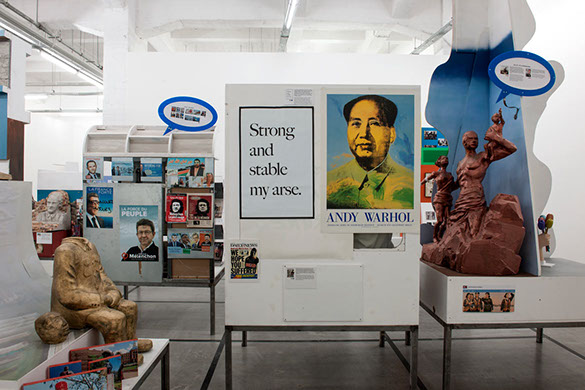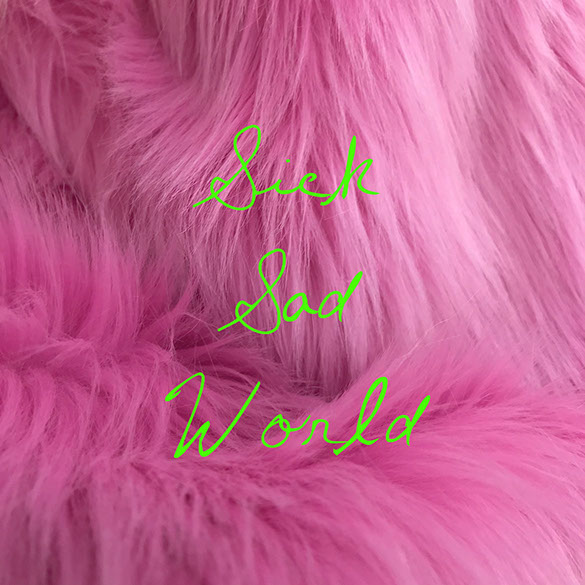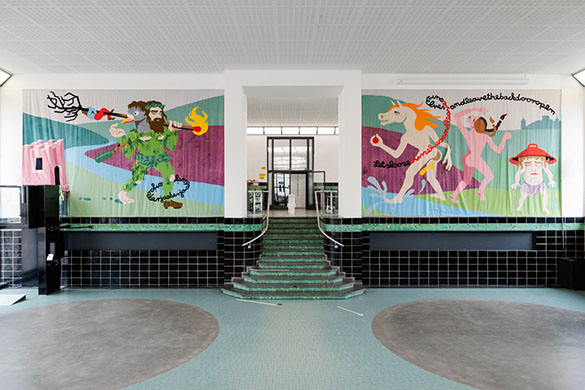Alexander Streitberger
Border-crossing
An interview with Dirk Snauwaert
Alexander Streitberger : To start with, I would like to look back to the years before you became director of WIELS, the contemporary art centre in Brussels, in 2005. Since 1989 you were responsible for several institutions and programs of contemporary art across Europe: the programming of contemporary art at the Palais des Beaux-Arts (PBA, now BOZAR) in Brussels, the Munich Kunstverein and the IAC Institut d’Art Contemporain in Villeurbanne/Rhône-Alpes. These institutions are, in fact, very different in terms of their geographical, cultural and political contexts as well as their exhibition and collection policies. From your today’s perspective, how do you think these experiences of different approaches to contemporary art have shaped your view on curating, exhibiting and collecting? To which extent were they relevant for the project of WIELS as an international art center in the heart of the European capital?
Dirk Snauwaert : As a start, I want to point out to a red thread that links all the different positions I held in my professional trajectory up till now, starting as exhibitions programmer for the local cultural center in the town I grew up in. This red thread is that they are all public institutions. I never considered working for the private or commercial sector of the art or cultural world, for art and ideas being emanations of individual labor are common and public matter that exist only if shared and debated in the public realm.
Although all public, their institutional orientation is quite different in scale, policy and purpose, ranging from the nation-state prestigious showcase which is the PBA or Palace of Fine Arts in Brussels, an exhibition palace for temporary presentations ranging from large scale block buster or cultural historical mainstream productions to cutting-edge, research and project-based contemporary exhibitions. The change to the Kunstverein Munich implied delving into an institution that could claim to be one of the oldest European institutions for the presentation and promotion of contemporariness in the arts, aside it then still being one of the spaces where a theoretical and art-historical profile for directorship was preferred over the scouting or impresario market-type profile, that is the “new discovery” type of curatorship. The IAC Villeurbanne was actually very different since it involved a large part of collection oriented activity, from acquisition policy to a major restoration and cataloguing campaign of the entire photographic fund which included nineteen-century pioneers of documentary and snapshot photography, conceptual art as well as the postmodern re-narrative photography of the eighties. Villeurbanne was actually quite well known territory because of the publishing activities of authors and artists associated with conceptual and critical theory by Art Edition, the publishing house of director Jean-Louis Maubant, with whom the Lawrence Weiner Learning to read art and the Daniel Buren Michel Parmentier exhibition at the Palace of Fine Arts had been co-produced. The correlation between collection building, commissioning a new work/project in the critical development of an artist and building an exhibition program around it in which the individual works and projects enhance each other and help inform and constitute an audience into a common critical and sensitive space became possible in a different way as was the case in the Palace of Fine Arts’ Antichambres or the Kunstverein Munich since these are limited to temporary presentations. In the PBA and Kunstverein I developed a very contextual orientation of the exhibition programming, punctuated with pioneering artists from the 1960s and 1970s who had initiated an utopian aim of knowledge and critique driven sensitivity, a line I sought to reconnect with and continuate. At WIELS elements of all these institutions, their programmatic orientations as well as of the partnering institutions these institutions operated with have influenced the fourfold articulation of the contents WIELS works at and for: not only an exhibition program that connects Belgium with the global development in art and critical thought, but also an international residency program aimed at artistic practice, an education department and a community based program oriented toward diasporic and transnational identities within Brussels and Western Europe.
A.S. : Indeed, the program of the WIELS convincingly demonstrates your understanding of art as a common and public matter that only exists if shared and debated in public realm. Beyond exhibitions and events organized in the context of residencies, this also includes a continuing dialogue with the academic world – be it in form of the organization of international conferences, lectures related to exhibitions, or book presentations. As an art historian who was implied in all types of activities mentioned above, I always had the impression that WIELS is one of the few places where these different perspectives – the academic, the artistic, and the curatorial – meet in a natural way and constitute equal parts of a laboratory based on the exchange of experiences, methods and contents. In your answer to my previous question you seem to suggest that this was exactly WIELS’s agenda right from the beginning. In fact, when I came to Brussels from Germany in 2005, there already existed some places dedicated to contemporary art – as for example Argos for the audiovisual arts scene or the contemporary art center ISELP – but an internationally acting and renowned art center was blatantly missing in the European capital. In my perception, this was the gap that WIELS set out to close. How do you situate WIELS within the specific cultural and socio-political situation in Brussels of the first decade of the 21th century? How did you react to the particular situation that you found in Brussels when you started as director of WIELS? How did the situation change over the last fifteen years and what does this mean for the positioning of WIELS (and its activities) within the local cultural landscape?
D.S. : My conception of how the content of an art institution is composed is very much influenced by what has been labeled institutional critique and more precisely the contextual practices of the late 1980s-90s. In these a combination of critical and subversive deconstructions of conventions and categories of the academized avant-garde ‘styles’ and formalisms which had become the legitimizers of prestige and socio-economic relations, paired with the application of theoretical and discursive frameworks of critical thinkers, be they inside or outside of academic institutions. This cross fertilization of subversion, deconstruction and popular culture, happened to coincide with the evolution of my private interest as a student – which is also to some extent a generational heritage of the no-future during the massive unemployment era, of punk rock and other types of provocation and nonconformism. In the advent of yuppification, voices like those of Stuart Hall, Frederic Jameson or Edward Said wrote incisive analysis of the status quo for which we blamed postmodernism’s indifference.
My studies of Broodthaers and later Buren, Graham, Asher, Jef Geys lead to receptivity of the work of Fareed Armaly, Christian Phillip Müller, Peter Friedl or Andrea Fraser, who themselves had a solid knowledge of thinkers and writers with a broad and sharp theoretical and academic scope, able to combine the political with pop and counter-cultural positions of critical theory. All that was very new to me then, a permanent discovery. Art institutions still considered themselves as places wherein only calm contemplation could reign, whereas art history still limited itself to considerations of the formal evolution of art, its techniques and its circulation – the model of classical art history if you want. The new methodology brought in by contextual reorientations turned away from the object, toward the processual, the distribution, the reception, status and norms of representation and categorization. It also closed the trending decades of styles.
The iron curtain coming down followed by the first Iraq war by Bush Sr was the signal that art valorization dynamics suddenly felt superficial and erroneously shallow. It shifted again towards questions of how context influenced production of meaning and value in the perception artefacts, as well as questions of the experience of spectatorship. The institutions I worked in and with became the object of scrutiny of all these specific questions concerning symbolical and economic relations. The post-structuralist word ‘exchange’ – which is still prevalent today – became very much the guiding principle for active authorship, spectatorship and organizational and institutional emancipatory frameworks.
So when I left Brussels in the mid 1990s, that questioning of the institutional framework had been widened towards systems of authority represented by these institutions. Identity politics concerning the discrimination of feminist or marginalized subcultures became supplanted by new identity politics concerning negated to even exterminated populations. Critical frames were introduced by indigenous artists, for examples in collaboration with artists such as Martha Rosler or Jimmie Durham. Leaving Brussels was caused principally by the absence of funding which lead to the absence of development perspectives, to the awareness that nothing that could resemble to a cultural policy had a chance in the segregating local linguistic communities. It drove me to abandon Belgium and seek abroad for situations that had at least a genuine involvement with contemporary questions and culture and give it space and means to develop. In the Palace of Fine Arts, where Herman Daled or Piet Coessens worked hard to obtain a permanent space for contemporary art, it was sensed that it was more used punctually as a gap filler between block buster operations and conventional cultural diplomatic exhibitions, as an alibi to keep the artists and amateurs quiet.
Yet in the course of my ten years absence, there had been the Brussels 2000 cultural festival (Brussels 2000: European Capital of Culture, director Robert Palmer), of which the biggest shared conclusion had been that there were no specialized spaces for art in Brussels. Then some initiatives grew into platforms that combined the European dimension of the capital with the grassroots enthusiasm of development of young emerging individuals and scenes, of which the most remarkable still is the Kunstenfestivaldesarts. For the latter Frie Leysen developed a discursive and programmatic overlap questioning the conventional representational complacency of the traditional bourgeois milieu in the Belgian capital, reluctant to find itself replaced by a transnational population originating from migration to globalization, a reality transforming many European capitals.
We entitled the first exhibition for WIELS with a programmatic ‘Expats and Clandestines’ title, referring to the nomadic reality of cosmopolitan artist practices but also to the fact that Brussels also is the European capital. The European governance does not really develop a cultural agenda, for it has to respect the sovereignty of national (or regional) predominance in matters related to culture. Nevertheless important cultural tropes and complex ideas are negotiated in the parliaments and commissions, for which no ‘sensible or material nor tangible’ manifestation is brought in which represents and allows to imagine the complex questions society is facing. As WIELS we have added this strata to the objectives that are important for the three public authorities that fund WIELS. For each of them the interface function between a local, regional, national and international art production and circulation is the most important issue. WIELS has added the level of Brussels as European Union’s administrative capital. This is a responsibility and opens up a dimension that should be developed on the level of a critical culture that questions the implications of the policies seeking to regulate everyday life and looking out for the vehicles of representation that make tangible and less abstract all the outcomes of checks and balances by which the Brussels bubble still regulates large parts of the globe.

Neïl Beloufa, L'Ennemi de mon Ennemi, 2018. Installation View, Risquons-Tout, WIELS, Brussels, 2020.
Courtesy of Neïl Beloufa Studio. Photo: Philippe de Gobert.
A.S. : If I understand well, it was the institutional critique of artists such as Broodthaers, Buren, Haacke, Fraser and others that influenced your thinking about the museum as a place where political, economic and institutional interests intersect, a position that radically opposes the model of the white cube offering a neutral space for the contemplation of autonomous art objects. On a theoretical level, you mention Stuart Hall, Frederic Jameson and Edward Said as important thinkers who wrote about identity politics and cultural hybridity within a postmodern, postcolonial world. It seems to me that these two issues – the socio-political conditions of the museum and the unsecured position of the subject within our globalized society – are at the very core of Risquons-Tout, the current exhibition at WIELS. In an essay printed in the catalogue that accompanies the exhibition you suggest that the very potential of art in order to resist tendencies of control, exploitation and exclusion within global neoliberalism would lie in the artists’ capacity of border thinking, that is to work in the unpredictable ‘in-between space of hybridity’ where cultural, social, sexual and economic distinctions are constantly put to the test. In fact, this is exactly how Homi Bhabba defines the interstice position of the postcolonial subject which articulates culture as ‘overlap and displacement of domains of difference.’ Would it be appropriate to describe the current exhibition in terms of such cultural overlaps and displacements taking place both within the artworks themselves and between the different spaces and sections in which they are presented? Could you further elaborate on the ways in which ideas and terms such as unpredictability, hybridity, interstice spaces and border-crossing guided your curatorial work in recent years and, particularly, in Risquons-Tout?

Tarek Lakhrissi, Sick Sad World, 2020. Courtesy of the artist.
D.S. : I think it’s clear for those who follow WIELS, the we work with concepts drawn from early Cultural Studies and methods of deconstruction developed by thinkers such as Bhabha and many others, with a recurring influx of Edouard Glissant’s ideas on alterity, difference, hybridity and cultural interdependency. These concepts are our building blocks and observation prisms in the apprehension of aesthetical practices, in which we search for singularities, for authorship in our times.
As discursive frameworks, they never are the finality, nor are they intellectual exercises of the theorist or curatorial type in order to invent displays or familiarize the art milieu with theories as if they were new forms of commodity. They are rather a tool to identify and situate practices.
While the expansionist art market and academic specialization have dominated most of the public opinion on art over the last three decades, as WIELS we continue to make a claim for the subversive and excessive elements of cultural production. Therefore we focused on the importance of risk and unpredictability in contemporary thought and creativity in a time where digital culture obviously produces less nuances and differentiation, but only conformity and polarizations.
The title Risquons-Tout is not just metaphorical but points to an existing space on a border, a bilingual hamlet on the French-Belgian border, a place famous for smuggling in pre-EU-times. Smuggling has to be understood as a form of translation and negotiation with existing codes. It’s a conception proposed by Cultural Studies as a form of non-authorized or rather tolerated appropriation and transaction, as an alternative economy of life. In the everyday reality of Brussels one can observe it daily, as a sign of inventiveness and transformation realized on the margins of the rules, subverting the prevailing management and accountancy culture for which promises of control, security and predictability are the doxa. Updating the question of mobility, from the mobility of people to that of information and data, we have widened our focus from a border-thinking understanding migration and transnational, diasporic identities as transgression, to the promise to break one of the ultimate limits, that of knowledge.
Modern techno-science indeed promises to solve this by computing and machine intelligence, and the European Commission has imposed a digital agenda on all member states, of which the digital transformation of everyday life is the biggest issue dominating everything from governing bodies to the public opinion. This dirigiste plan for another ‘big leap forward’ with cyber-technology and the internet of things, the question of other and different forms of knowledge, the access to knowledge, and the uniformization by rational cognitive forms of intelligence increasingly unleashes critical thinking. Bringing in both non-human forms of intelligence in ecological organisms as well as ancestral, emphatic, non-cognitive forms of apprehension and intelligence is central to discussions in the artworld. Both questions of the border and limit have been the echo-chamber for the many new productions we have commissioned for the Risquons-Tout exhibition.

Kati Heck, Schwarzes Brett I & II, 2020. Cotton, 406 × 650 cm. Installation View, Risquons-Tout, WIELS, Brussels, 2020. Courtesy of Tim Van Laere Gallery, Antwerp. Photo: Alexandra Bertels.
An important criterium in the selection of the artists, who work in the territory of the Eurocore or the extended Lowlands, is their challenging of norms and conventions. It is precisely for this reason that we did not focus on artists who fantasize about digital cultures’ synthetical archetypes, but on those who still take risk in their work and do not content themselves with developing a personal style, a recognizable imprint, a typical iconography, a reductive approach by issue picking – all those criteria which define our artworld under the influence of the art market, the post-media question and the agendas of critical thinking. In the digital era, singularity is a token word for promoting artificial intelligence, as opposed to what it means in the humanities and the artworld: that which is incomparable to anything else, that which always remains unpredictable.
Brussels, December 2020
ARCHIVES
